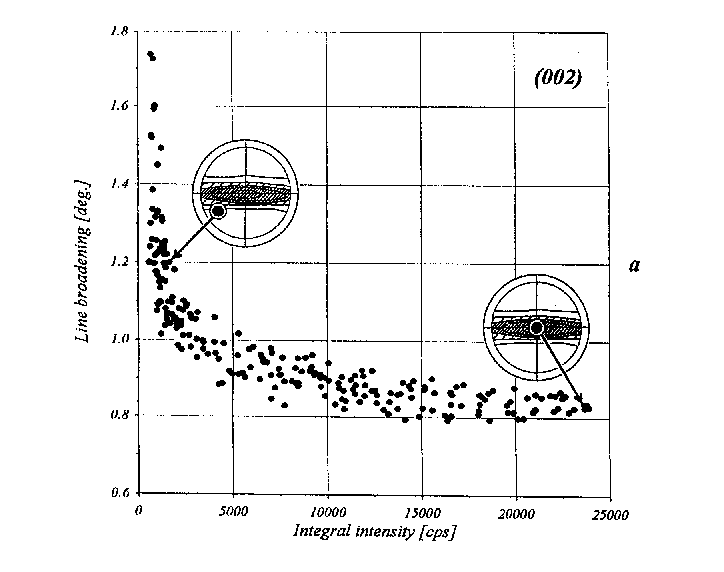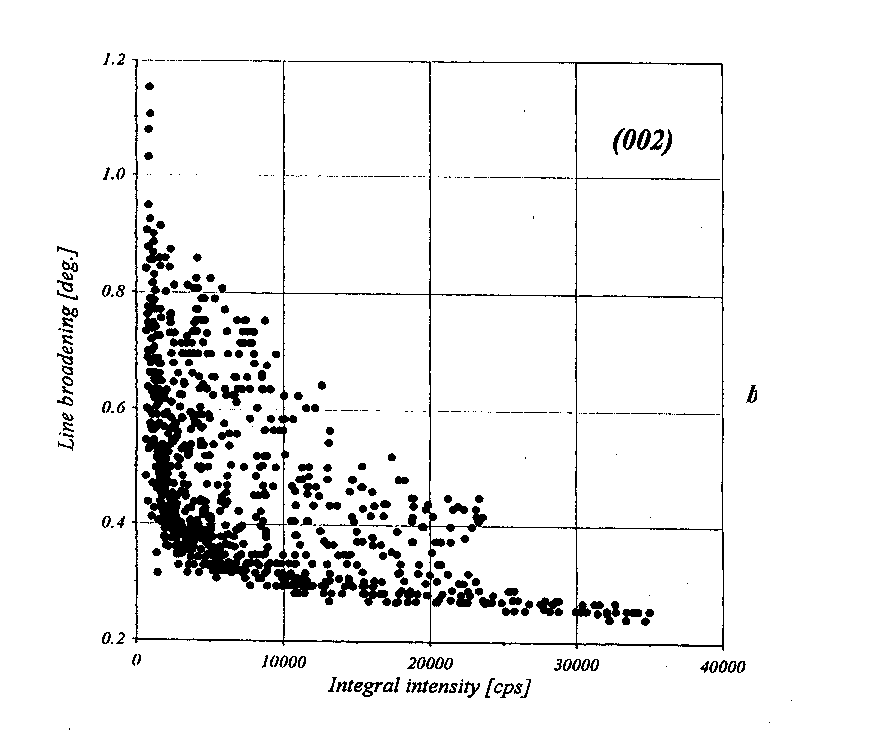
TYPICAL FEATURES OF SUBSTRUCTURE INHOMOGENEITY OF TEXTURED MATERIALS
Yu.Perlovich1, H.J.Bunge2, M.Isaenkova1, V.Fesenko1
1Moscow Engineering
Physics Institute, Kashirskoe shosse 31, Moscow 115409, Russia
2Institut fur
Metallkunde und Metallphysik, TU Clausthal, Grosser Bruch 23,
Clausthal-Zellerfeld 38678, Germany
Keywords: rolling
texture, substructure inhomogeneity, physical broadening of X-ray
line, correlation between integral intensity and line broadening.
X-ray diffractometric measurements by application of a position-sensitive detector proves to be very advantageous by systematic studies of the inhomogeneous distribution of residual deformation effects in textured metals depending on grain orientation, provided that the experimental data are carefully corrected for instrumental factors. The physical half-width of X-ray line was used as a characteristic of the condition of the crystalline lattice along the normal to reflecting planes {hkl}, when taking into account that the true broadening of X-ray lines is connected with effects of lattice distortion and coherent domain length. For a number of rolled metal materials distributions of X-ray line broadening in the stereographic projection were constructed and their correlation with texture pole figures was analyzed. It was revealed that these distributions obey distinct regularities, that is the crystallographic orientation is an effective criterion for systematization of substructure inhomogeneities in rolled materials with developed textures.
The following main features of substructure inhomogeneity in textured metal materials are bound to be noticed:
1) The physical half-width of X-ray lines varies over the whole range of values accessible for measurement with a satisfactory precision, i.e. around 0.2-2o. Hence, within textured material there are crystalltes corresponding to the very wide spectrum of lattice condition .
2) The physical broadening of X-ray lines, that is lattice distortion and grain fragmentation, increases as the normal to the reflecting plane moves away from the texture maximum to the neighbouring texture minimum.
3) Maxima of line broadening are situated within minima of the texture, and conversely, the central regions of texture maxima correspond to the minimal values of line broadening. Hence, most dispersed crystallites with a distorted lattice are located in texture minima, whereas relatively coarse crystallites with a rather perfect lattice correspond by their orientations to texture maxima.
The most spectacular illustration of the foregoing regularities is given by diagrams of correlation between distributions of integral intensity and physical half-width of registered X-ray lines. Such diagrams are presented in Fig.1 for the b-Zr phase in the rolled quenched alloy Zr-20%Nb (a) and for the cold-rolled Nb foil (b). In both cases the X-ray line (002) was registered, that is diagrams characterize the condition of crystalline lattice along cubic normals. Each point in the diagram responds to a point in the stereographic projection of the sample, so that all points prove to be ordered depending on the integral intensity of the X-ray line observed by successive positions of the sample.


Fig.1. Diagrams of
correlation between integral intensity and line broadening of the
X-ray line (002) for the b-Zr phase in the rolled quenched
alloy Zr-20%Nb (a) and for the cold-rolled Nb foil (b). Angular
radii of treated regions of pole figures {001} are 25o
and 70o, respectively.
The diagrams show two regions with different inclinations testifying that there are two distinct types of the correlation between broadening and integral intensity of the X-ray line. As the integral intensity decreases from high values, the broadening b exhibits at first a slow though reliable increase, which occurs to be replaced by a very sharp rise for integral intensities less than 10% of the maximal value. While the simple diagram for the b-Zr phase characterizes the distribution of line broadening only within the central region of the pole figure {001}, that is for grains with orientations close to {001}<011>, the more complicated diagram for the Nb foil includes additionally points belonging to the component {011)<001>, which is not typical for rolling textures of bcc-metals and forms usually in surface layers. Hence, line broadening changes in different manners within texture maxima and texture minima, as well as near texture maxima of different components.
A model was proposed to
explain the principal character of the observed substructure
inhomogeneity by the action of mechanisms responsible for the
maintenance of final stable orientations. Strain hardening
results in violation of balanced action of mutually symmetric
slip systems, so that the orientation of crystallite moves away
from the top of texture maximum to its slope, where a value of
the Schmid factor for the inhibited system proves to be
sufficient for the further slip.